L2O
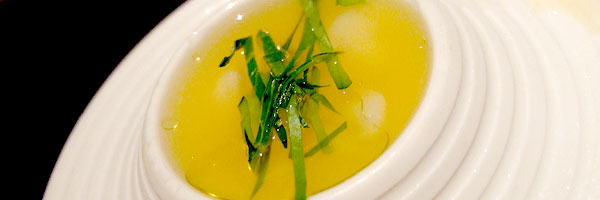 |
|
| Scallop Ceviche with Orange and Parsley | Dominic Armato |
In his restaurant blog for L2O (which, incidentally, is a really exceptional behind the scenes look at running a fine dining restaurant, both the fascinating and the absurd), Laurent Gras mentions how everybody asks him, "Why Chicago?" It's an unfortunate reminder that too many people still haven't gotten the memo that we serve more than steak and pizza. And I hate to even mention it, because there's no sense in preserving a long-undeserved reputation by having a chip on your shoulder. But still, there's been a little too much "A seafood-focused fine dining restaurant? In Chicago??? Why, I think I'm getting the vapors!" going around. That bit of annoyance aside, it is nice to see that Chicago can now boast what was even somewhat consciously conceived as a response to Le Bernardin, and that it's gotten what has been, for the most part, very positive national attention that avoids the "fish restaurant in cowtown" conceit.
If you've been paying attention, you don't need me to give you the book on L2O (but I will, of course). Highly-lauded chef whose resume reads like a who's who of French heavyweights with Michelin hardware is lured away from the coasts by a Chicago restaurateur to fill a specific gap in the local dining scene by creating an uncompromising fish-focused fine dining restaurant. Esquire names it the best new restaurant of 2008, the James Beard Foundation considers following suit by making it a short list nominee for the same, and Frank Bruni even stops in to swoon a little bit. All of which raises the terrifying question, giving the unfortunate timing of its launch, of whether such a welcome addition to the scene will manage to survive. These aren't exactly heady times for places that are making dishes with gold leaf and shiso flowers flown in from Japan. Quick preview? I both hope and think it will.
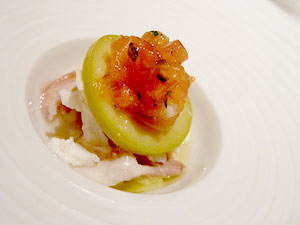 |
||
| Halibut Cheek with Tomato Concassé | Dominic Armato | |
The good news is that they didn't seem to be hurting when we stopped in, with every visible seat filled on a Wednesday night. Housed in the old Ambria space, you have to trundle through the old school lobby of the Belden-Stratford, squeeze through a narrow, unmarked door and navigate a forest of ebony columns to locate the dining room. A little dramatic, sure, but there's a part of me that enjoys it when fine dining restaurants don't pretend not to be ridiculous. It's a cool room that's dim and very modern and has a bit of a contemporary Japanese feel to it, which makes sense given how heavy of an influence Japanese cuisine is on the menu. In fact, there are two traditional tatami rooms off to the side that serve a special menu unique to them. Each table is also hit with a bright overhead spot which is, I'm a little embarrassed to admit, one of my favorite qualities in a restaurant these days, for reasons that should be obvious.
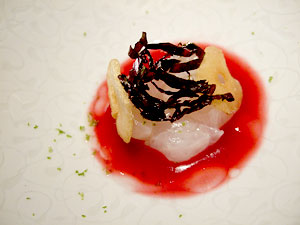 |
||
| Fluke with Umeboshi Vinaigrette | Dominic Armato | |
The basic menu is a four course prix fixe, and in addition to the kaiseki menu served in the tatami rooms, there are two tasting options, a 12-course seasonal menu and what Gras calls his Tête à Tête: an eight course tasting where each plate features two very minimally presented ingredients that are supposed to create an unusually harmonious whole. And while the concept of the Tête à Tête was intriguing, it's hard not to do a basic seasonal menu on your first pass, so we did. Though not exclusively of the sea, there's no doubt that this is fish-focused fare, right down to the glossary (yes, the glossary) of Japanese fish terms that accompanies your menu (apparently there are some pretentions I could do without). Gras is French by birth and training, and that's clearly where the menu is rooted, but it works in a horde of Japanese influences in both low and high-tech manner. Browsing through Gras' blog, it's impressive how much MG hardware has made its way into L2O's kitchen. Even more impressive is how casually much of it is integrated, but I'm getting ahead of myself.
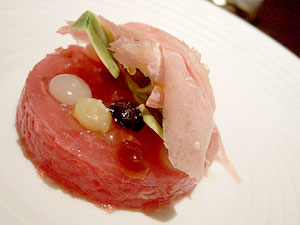 |
||
| Tuna Tartare | Dominic Armato | |
I'm not one to make a big deal out of bread service, but L2O's really is exceptional, providing six or seven selections in miniature form that are baked twice during the evening's service. What's more, though it seems a touch unnecessary, the butter is churned in-house, and it's delicious. Though it was tempting to make a meal of the bread, we managed to keep our consumption at reasonable levels (they only had to refill the butter dish once!) until the first dish hit the table, which was a bay scallop ceviche amuse with orange and parsley. It was clean little sweet and acidic shot, very heavy on the orange, that got us rolling nicely. This was followed in short order by another amuse, this one a clear shout out to Gras' roots on the French Riviera. A tender and flaky bit of halibut cheek, swimming in olive oil, was topped with a sliver of green olive and a dollop of tomato concassé. Given the ceviche's spiritual origins, I won't talk about this being an East-West setup for an East-West menu, though that interplay of bright, clean acid and more grounded, midrange flavors was certainly a little bit of foreshadowing.
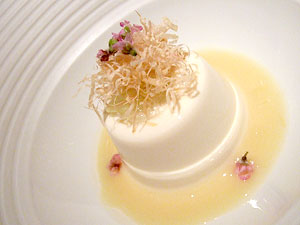 |
||
| Tofu with Miso Bouillon | Dominic Armato | |
The menu's first official dish was the first of two raw seafood preparations, a fluke sashimi in an iridescent umeboshi vinaigrette with what appeared to be some type of dried seaweed, crispy fried garlic slices and a light grating of zest from some sudachi, a limelike Japanese citrus fruit. Umeboshi, for those who may not be familiar with it, is a type of pickled Japanese plum, but don't let that fool you into thinking there was anything sweet going on here. Umeboshi is incredibly sour, very salty and pungent, and a big surprise the first time you taste it. This dish was no exception. And between the puckering vinaigrette and garlicky garnish, I was a little surprised that the fluke held its own, but it absolutely did, that clean, fresh flavor somehow cutting through the noise. A good start.
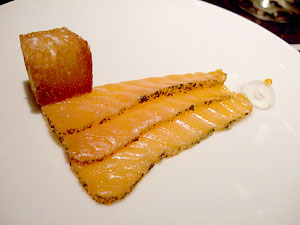 |
||
| Smoked Salmon with Earl Grey | Dominic Armato | |
There's little better than when a dish rekindles my love for something I thought I'd grown tired of, and our second course was exactly that. I've almost completely given up on ordering raw tuna. In sushi bars, it's almost always a flavorless slab of fish-textured protein. When served as the ubiquitous tuna tartare, it's usually slathered with so much gunk that it's impossible to taste the fish (which, come to think of it, isn't so bad since it's almost always a flavorless pile of minced, fish-textured protein). These days, I only order raw tuna at places where it's guaranteed to be spectacular. And then only if I can get some otoro or something with a little fat on it for cryin' out loud. Our second course, however, reminded me that I can't stay mad at raw tuna. "Pristine" is so overused. What's more pristine than pristine? Immaculate, I suppose, though that's not much less of a cliché. In any case, we're talking full-on biblical-style immaculate diced tuna here, topped with a green he referred to as crystal ice lettuce, and MG-looking beads of soy, dashi and olive oil emulsions. On top, more tuna that had been frozen and sent through a Hawaiian ice shaver (no joke), topping ice cold with ice ice cold. This was a beautiful example of molecular gastronomy's positive legacy, a completely traditional collection of flavors put through the technical wringer and turned into something special. I loved this dish.
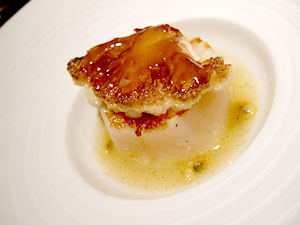 |
||
| Scallop with Caramelized Cauliflower | Dominic Armato | |
Our third course, though less striking, was quite lovely in its own right. Another Japanese-focused dish, it started with an exceptionally light and creamy block of house-made tofu, which was topped with itogaki (think shaved bonito, but a less aggressively flavored version made with bluefin tuna) and shiso blossoms, and sat in what was termed a miso "bouillon". That the tofu was so delicate dictated that the other components would be as well, making the more refined itogaki a thoughtful substitution rather than a merely pretentious one (though I'm not certain the same can be said of the imported shiso blossoms). The miso bouillon was similarly mellow, avoiding the sweet trap and letting the tofu come through, as it should if you're going to go to the trouble of making it yourself.
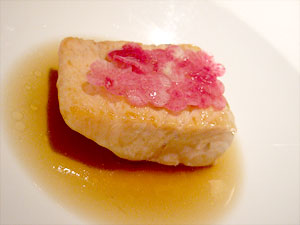 |
||
| Robata-Yaki Coho Salmon | Dominic Armato | |
The smoked salmon, even if I found some of its accompaniments a little silly, stopped me dead in my tracks. The ginger gelée tasted more of gelée than ginger, which is to say it didn't taste of much at all, and though I thought the sea trout roe a lovely companion to the fish, the fact that we were presented with a single egg was flat-out comical (look carefully -- if you turn your head and catch the light just right, you might see it!). But the dish had a heart of gold, three slivers of buttery smoked salmon more jaw-dropping than anything I tasted at Russ & Daughters, crusted with a touch of Earl Grey tea and sitting next to a perfectly crisped crouton for texture. Absolutely dynamite.
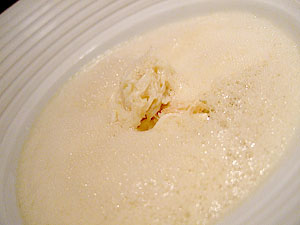 |
||
| Peekytoe Crab with Foie Gras Emulsion | Dominic Armato | |
It's tough to have a scallop with caramelized cauliflower and not think of Jean-Georges Vongerichten, and that may very well have been the intention. And though this was one stunner of a scallop, I'm not sure that sauvignon blanc-passionfruit-vanilla will be usurping caper-raisin as my favorite sauce for this particular pairing, but an excellent dish nonetheless. Our first truly substantial piece of fish was my sole disappointment of the evening. Robota-yaki (Japanese wood-grilled) Coho salmon with breakfast radishes, watermelon radishes and a ginger-beef bouillon, though beautifully prepared, was just far too subtle for my tastes. Balanced, yes, and it's nice to see radishes featured so prominently and so well, but to me it just played a little flat.
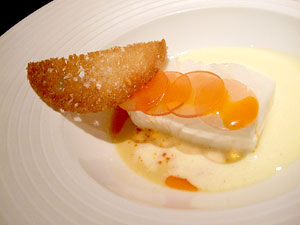 |
||
| Halibut with Corn and Chorizo | Dominic Armato | |
The next dish was anything but. I don't think I was influenced by my joy over once again seeing foie gras on Chicago's menus, but it couldn't have hurt. The thought that not long ago this would have been contraband is simultaneously maddening and hilarious. Peekytoe crab was poached in butter and almost lost in a sea of foamy foie gras emulsion. The flavor was explosive and decadent, and the light, frothy texture of the foie gras emulsion took something that might have ordinarily steamrolled the delicate crab, and instead turned it into a supporting flavor that maintained its luxurious decadence without completely stealing the spotlight. This was one of the best uses of foie gras I've seen in a long time, a powerfully flavorful dish, and probably my favorite of the evening.
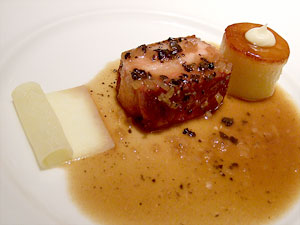 |
||
| Pork Belly with Truffle Jus | Dominic Armato | |
The next dish's flavors went off into left field a little bit, pulling corn and chorizo into a menu that had been almost exclusively French and Japanese up until then. The centerpiece was a slab of butter-poached halibut sitting in a bowl of creamy corn that acted as though it set out to become a custard and stopped halfway. Swirled into the corn emulsion was a splash of olive oil and a subtly but distinctly-flavored chorizo broth, and hidden in the bottom were a few stalks of white asparagus. On top were discs of chorizo gelée and a thin bread crisp. While the texture of the bread was certainly appreciated, I'm not sure that the gelée really had anything to contribute other than appearances. But as for the rest, while I'm ordinarily a little leery of any preparation that takes the teeth out of an inherently potent ingredient like chorizo, it really worked well and helped keep the focus on what was, unsurprisingly, a beautiful piece of fish.
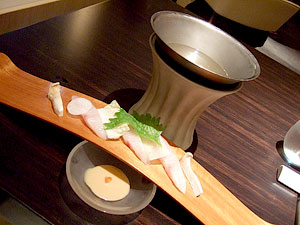 |
||
| Yellowtail Shabu Shabu | Dominic Armato | |
Shockingly, L2O does, in fact, serve a non-aquatic protein from time to time. And while we weren't fortunate enough to be treated to the Miyazaki Wagyu (no surprise -- it's a $75 supplement for a 3-ounce portion on the prix fixe menu), pork belly hasn't yet gone the way of raw tuna for me, and I'm always happy to see a chunk of it land on my plate. Here, it was doused with a truffle jus and bracketed by potatoes, a thin sliver on the left and a caramelized Yukon gold on the right that was stuffed Twinkie-style with a creamy pureed potato filling. Though the flavors were straightforward and spot on, I confess that I'm unsure of how I feel about the pork belly. It was significantly firmer -- perhaps even bordering on tough -- than convention would dictate. I'd consider it a possible error, but a little reading around reveals that I'm not the only one to have been caught off-guard by the texture. A kitchen like this doesn't habitually botch their dishes, so I'm forced to conclude that it was completely intentional. I'm not seeking fork-tender pork belly monoculture. But I'm not convinced this wasn't a little tougher than it should have been. When handling the flatware without launching it becomes a challenge, I'm thinking there's an error of either conception or execution in there somewhere.
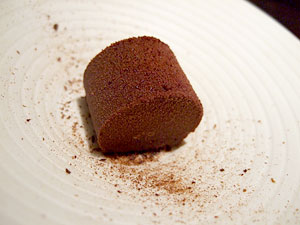 |
||
| Chocolate Ganache with Soy | Dominic Armato | |
Our savory cooldown course required something of an apparatus, which looked like the Architectural Digest version of a chalice, holding hot chicken broth and set behind a board with sliced hamachi, mushroom, napa and shiso leaf. When a small bowl of goma-su was set in front of the fish, my suspicion morped into expectation, and later confirmation when I inadvertently blurted out, "Shabu Shabu," to which our server replied, "That's right," though it couldn't have been more obvious at that point what was going on. Sadly, though I adore shabu shabu, I felt this was a weak dish. the goma-su felt flat to me, and I'm not convinced that the fish was improved by a trip through the hot broth, no matter how brief. But that was some dynamite hamachi.
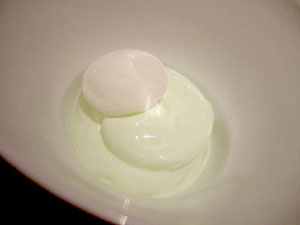 |
||
| Kaffir Lime with Coconut Cloud | Dominic Armato | |
Desserts were fast and furious, starting with a dark chocolate and olive oil ganache with a touch of soy sauce (the size of a large marble, since the photo gives no sense of perspective). I'm unsure whether the soy was worked into the ganache or constituted the powder on top, but the flavor was subtly and unmistakably there. I doubt Gras is the first to accent chocolate with soy sauce, mostly because it seems so obvious, in retrospect, that soy's saltiness and dark caramel flavor would pair well. It made for a delicious and slightly unconventional bit. Next, a kaffir lime foam hid a small pile of diced pineapple beneath, and was crowned with a coconut "cloud", which was a light and airy crisp that melted away into nothingness after an initial crunch. It was refreshing and delicious and an excellent use of edgy tech.
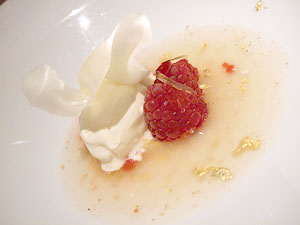 |
||
| Raspberry with Yuzu-Honey Consommé | Dominic Armato | |
The third dessert, for somebody who likes light and refreshing desserts like me, was a total showstopper, even if it was a bigger production than it needed to be. Raspberries and slivers of lemon confit sat next to a quenelle of unsweetened mascarpone sorbet, atop of which was a crisp ribbon of white chocolate. Our server then produced a vial with a small, golden log inside -- some manner of honey and yuzu gelée that had been coated with gold leaf. He poured a similarly composed broth of yuzu and honey into the vial and shook it, dissolving the log and leaving a gold-flecked broth which was poured around the dessert. The flavors were dynamite, the honey taking the edge off the yuzu's punch, which in turn cut the richness of the mascarpone... I loved it. But gold leaf always strikes me as a little ridiculous, even within a fine dining context, and I'm not sure what the whole "magical dissolving log" thing accomplished that simply pouring a broth wouldn't have other than giving the server something to do and calling your attention to the fact that they were using gold leaf. I don't mind a little showmanship at this level, but I like to think it's somehow meaningful from a culinary standpoint, even if just barely.
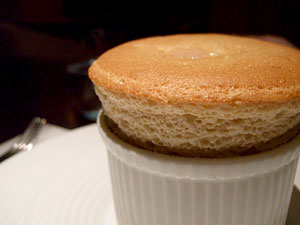 |
||
| Praline Soufflé | Dominic Armato | |
Gras then sent us off with some more traditional tastes of his birthplace, starting with a praline soufflé with vanilla, Frangelico and dark rum. This was a textbook preparation, light and moist and airy with a slightly crusty top, the sauce drizzled into a hole in the center so that the soufflé could soak it in. Mignardises included a little treat I'd read about but am embarrassed to admit I'd never tasted. Canelés are little (in this case, golf ball-sized) custards, poured into molds that look like elongated Bundt cake pans and baked until the outer edges turn a crisp, deep brown with a heavy caramelized flavor, while the interior remains pale and moist. It's a delightful textural and flavor contrast that I'm pleased to have finally tasted. And before our departure, a perfectly crisp/moist/gooey macaroon of the coffee and chocolate persuasion arrived to see us off.
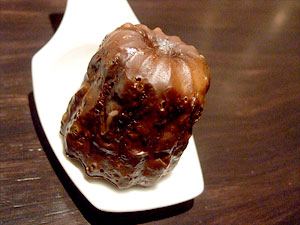 |
||
| Canelé | Dominic Armato | |
Though I knew the name, I knew little of Gras' cuisine before sitting down to dinner. On one hand, given how pervasive the Japanese influence was on this menu -- about half of the dishes put uniquely Japanese flavors front and center -- I was a little surprised that I couldn't find any reference to him spending any length of time cooking in Japan. But upon further reflection, I suppose I shouldn't be. There's little on display in the way of Japanese technique. Rather, these dishes are those of someone who has fallen in love with Japanese flavors and worked them into his own style, in this case that of a French background with a healthy dose of MG. Gras' use of MG, however, is fairly restrained, as it goes. Oh, he has the toys. Reading through the L2O blog, you can only envision Rich Melman sitting there, shaking his head as invoices for dehydrators, Pavaillers, freeze-dryers, cold-smokers, Hawaiian ice shavers, Gastrovacs, rotary evaporators, etc. go flying by at breakneck speed. But this isn't the "pay attention to me!" MG of some of his contemporaries. There's some flash, but there's also a lot of restraint, and I suspect this approach is more indicative of the future of zany kitchen technology.
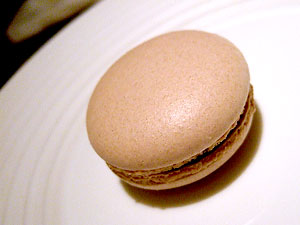 |
||
| Coffee and Chocolate Macaroon | Dominic Armato | |
Which sort of segues into the final thought I was left with as we pulled away from the Belden-Stratford. Between the state of the world economy, the booming popularity of humble, snout-to-tail, locally-sourced cuisine, and the propagation of chefs who could do more upscale work but choose to keep things simple and casual, there are many who believe that fine dining is going or should go the way of the dinosaur. I confess, in the current climate, it's a little weird to research a restaurant that's flying in tiny boxes of microgreens from Japan and spending a fortune on the kind of technology that would make any mad scientist worth his salt green with envy. It just seems so at odds with today's culinary scene in so many ways. But here's a chef who's taking that spare-no-expense opportunity and doing some really wonderful things with it, and I find myself thinking about how unfortunate it would be if L2O didn't make it. Fact is, this was one of the most exciting meals I've had in recent memory, and despite L2O's youth I found it more compelling and delicious than all of Chicago's other fine dining options with the exception of Alinea, and that, perhaps, only because Alinea is such an incredibly unique experience that it's hard to even judge it in a traditional fine dining context. This is cuisine that could not be replicated without a big budget and the accompanying big price tag, and if it were to quietly slip away I'm convinced that something would be lost. Not something inherently greater or more noble -- I don't subscribe to the theory that fine dining is somehow the pinnacle of food, or even slightly more worthy than any other style of cuisine -- but something that's simply irreplaceable in any other context. I guess what I'm trying to say is that when people say there's something wrong with fine dining, I'm forced to recognize that dining doesn't get much more fine than L2O, and believe me, there's nothing wrong with L2O.
| L2O | |
| www.l2orestaurant.com | |
| 2300 North Lincoln Park West | |
| Chicago, IL 60614 | |
| 312-868-0002 | |
| Sun - Mon, Wed - Thu | 6:00 PM - 10:00 PM |
| Fri - Sat | 6:00 PM - 11:00 PM |

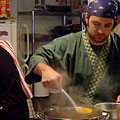
Everything looks so modern art. GeoMetric.
You are so good at photo food... food pr0n. xxx
Posted by: dc | November 13, 2009 at 07:31 AM
This menu actually didn't even have some of the more striking plates I've seen recorded elsewhere. As his presentations go, these are pretty tame.
Posted by: Skillet Doux | November 13, 2009 at 07:34 AM
Well, to be fair, the fact that we're so damned far inland does make a high-end seafood restaurant a bit more difficult.
Posted by: Independent George | November 14, 2009 at 09:46 AM
"Well, to be fair, the fact that we're so damned far inland does make a high-end seafood restaurant a bit more difficult."
To be more fair, I think, Le Bernardin isn't exactly pulling their kampachi, Alaskan salmon, sea urchin, langoustine, kumamoto oysters, escolar and hiramasa out of the Hudson :-)
Posted by: Skillet Doux | November 14, 2009 at 09:57 AM
Your descriptions are so good I feel like I just ate the meal myself. What was the price per person of the meal that you had? Just wondering if this is a place to dream about or a place that I can actually eat in some day.
Posted by: Danny | November 14, 2009 at 01:19 PM
Danny... seasonal tasting runs $165.
Posted by: Skillet Doux | November 14, 2009 at 01:59 PM
...plus Chicago's 11.5% sales tax.
Posted by: Chris Benejam | November 14, 2009 at 04:27 PM
Wow, that's a reasonable price for such a varied mean with so many (sometimes needlessly - I sure agree about the gold leaf) expensive ingredients.
I'm going to Boston in a few weeks just to spend a weekend there. Any suggestions? Would like strong seafood choices and where is the best chowder anywhere there - shacks and corner stands included?
Posted by: Danny | November 14, 2009 at 04:38 PM
Excellent - I too had a fantastic meal at L2O and rank it favorably with the best in the United States.
Posted by: uhockey | March 06, 2010 at 12:28 AM